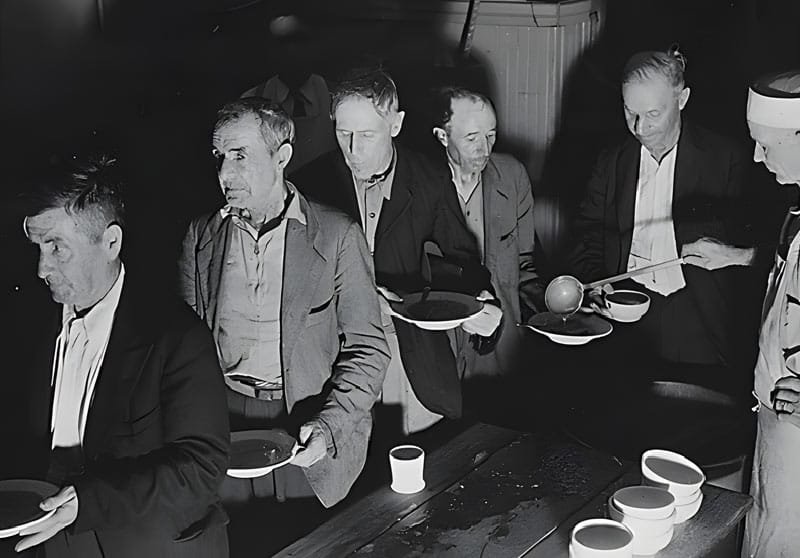Great Depression
The Great Depression was a worldwide economic downturn which started in October of 1929 and lasted through most of the 1930s. It began in the United States and quickly spread to Europe and every part of the world, with devastating effects in both industrialized countries of raw materials. International trade declined sharply, as did personal incomes, tax revenues, prices and profits. Cities all around the world were hit hard, especially those dependent on heavy industry. Unemployment and homelessness soared. Construction was virtually halted in many countries. Farming and rural areas suffered as prices for crops fell by 40–60%. Mining and logging areas had perhaps the most striking blow because the demand fell sharply and there were few employment alternatives. The Great Depression ended at different times in different countries; for subsequent history see Home front during World War II. Most countries set up relief programs, and most underwent some sort of political upheaval, pushing them to the left or right. Democracy was weakened and on the defensive, as dictators such as Hitler, Stalin and Mussolini made major gains, which helped set the stage for World War II in 1939.
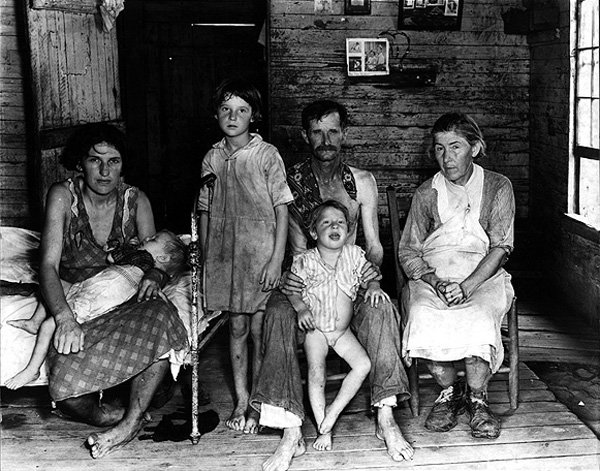
MIGRANT FAMILY – NATIONAL ARCHIVES
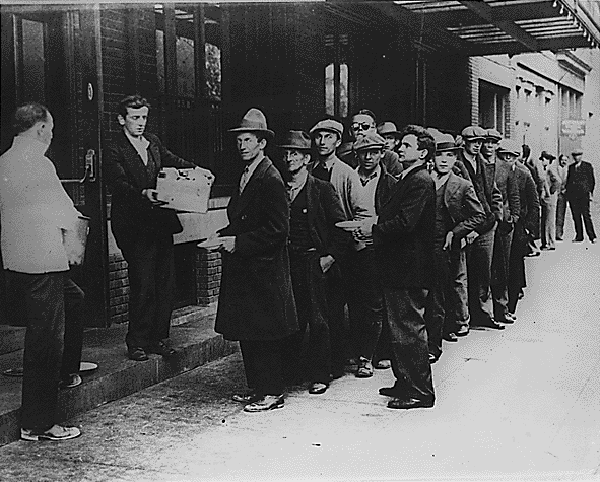
FOOD LINE FOR UNEMPLOYED – NATIONAL ARCHIVES
Causes
Americans were not purchasing but saving. The only consensus viewpoint is that there was a large scale lack of confidence. Unfortunately, once panic and deflation set in, many people believed they could make more money by keeping clear of the markets as prices got lower and lower and a given amount of money bought ever more goods.
There are multiple reasons on what set off the first downturn in 1929, concerning the structural weaknesses and specific events that turned it into a major depression, and the way in which the downturn spread from country to country. In terms of the 1929 small downturn, historians emphasize structural factors like massive bank failures and the stock market crash, while economists point to Britain’s decision to return to the Gold Standard
Debt
In the 1920s, in the U.S. the widespread use of purchases of businesses and factories on credit and the use of home mortgages and credit purchases of automobiles, furniture and even some stocks boosted spending but created consumer and commercial debt. People and businesses who were deeply in debt when a price deflation occurred or demand for their product decreased were often in serious trouble—even if they kept their jobs, they risked default. Many drastically cut current spending to keep up time payments thus, lowering demand for new products. Businesses began to fail as construction work and factory orders plunged. Massive layoffs occurred, resulting in unemployment rates of over 25%. Banks which had financed a lot of this debt began to fail as debtors began defaulting on debt and bank depositors became worried about their deposits and began massive withdrawals. Government guarantees and Federal Reserve banking regulations to prevent these types of panics were ineffective or not used. Bank failures led to destruction of billions of dollars in assets. Up to 40% of the available money supply normally used for purchases and bank payments was destroyed by all these bank failures.
Furthermore, the debt became heavier, because prices and incomes fell 20–50%, but the debts remained at the same dollar amount. After the panic of 1929, and during the first 10 months of 1930, 744 banks failed. In all, 9,000 banks failed during the decade of the 30s. By 1933, depositors saw $140 billion of their deposits disappear due to uninsured bank failures. Unfortunately, bank failures snowballed as desperate bankers tried calling in loans which the borrowers did not have time or money to repay. With future profits looking poor, capital investment, construction etc. slowed or completely ceased. In the face of bad loans and worsening future prospects, the surviving banks became even more conservative in their lending. They built up their capital reserves, which intensified the deflationary pressures. The vicious cycle developed and the downward spiral accelerated. This kind of self-aggravating process may have turned a 1930 recession into a 1933 depression.
In dollar terms, American exports declined from about $5.2 billion in 1929 to $1.7 billion in 1933; but prices also fell, so the physical volume of exports only fell in half. Hardest hit were farm commodities such as wheat, cotton, tobacco, and lumber. According to this theory, the collapse of farm exports caused many American farmers to default on their loans leading to the bank runs on small rural banks that characterized the early years of the Great Depression.
By not acting, the Federal Reserve allowed the money supply to shrink by one-third from 1930 to 1931. Friedman argued the downward turn in the economy starting with the stock market crash would have been just another recession. The problem wasn’t some large, public bank failures, particularly the Bank of the United States, produced panic and widespread runs on local banks, and that the Federal Reserve sat idly by while banks fell. He claimed if the Fed had provided emergency lending to these key banks, or simply bought government bonds on the open market to provide liquidity and increase the quantity of money after the key banks fell, all the rest of the banks would not have fallen after the large ones did and the money supply would not have fallen to the extent and at the speed that it did. With significantly less money to go around, businessmen could not get new loans and could not even get their old loans renewed, forcing many to stop investing. This interpretation blames the Federal Reserve for inaction, especially the New York branch, which was owned and controlled by Wall Street bankers. The Federal Reserve, by design, was not controlled by the President or the U.S. Treasury; it was primarily controlled by member banks and the chairman of the Federal Reserve.
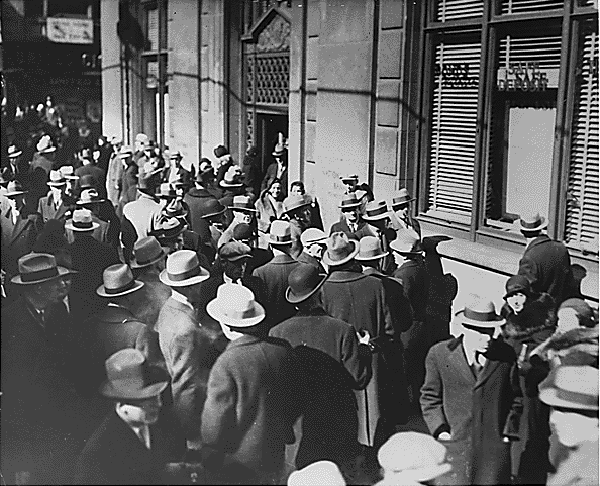
CITIZENS AND CLOSED BANK – NATIONAL ARCHIVES
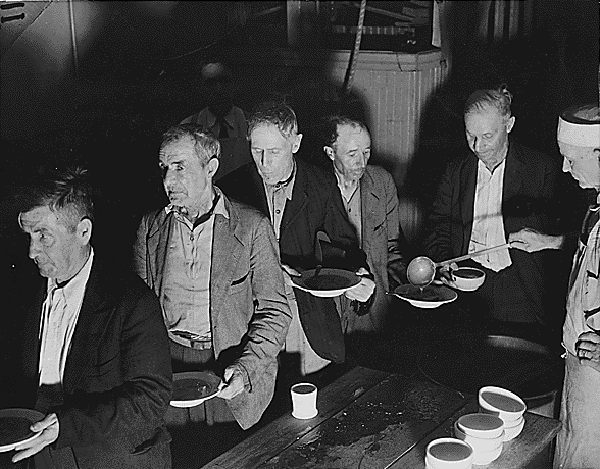
DEPRESSION SOUP LINE – NATIONAL ARCHIVES
Business
Franklin D. Roosevelt, elected in 1932, primarily blamed the excesses of big business for causing an unstable bubble-like economy. Democrats believed that the problem was business had too much power, and the New Deal was intended as a remedy, by empowering labor unions and farmers (which it did) and by raising taxes on corporate profits (which proved a failure). Regulation of the economy was a favorite remedy. Some New Deal regulation (the NRA and AAA)) was declared unconstitutional by the U.S. Supreme Court. However the Securities and Exchange Commission, Federal Reserve, Social Security and other laws and regulations won widespread support which continues to this day.
Government deficit spending
Massive increases (by 1930s standards) in taxes, deficit spending, new banking regulation, and so forth, did start turning the U.S. economy around in 1933 but it was a slow and painful process with the U.S. not returning to 1929’s GNP for over a decade and still having a unemployment rate of about 15% in 1940–down from 25+% unemployed in 1932 but still high. The unemployment problem was not “solved” until the advent of World War II and the drafting of 11 million men, removing about 20% of the work force. All the deficit spending during World War II did little initially to improve the economy even though nearly everyone who wanted a job could have one. Rationing and wage controls meant a limited supply of consumer goods, as 40% of the economy went to war production. Finally by about 1944 all of this deficit spending and investments in capital goods started showing up in the civilian economy as ten years of depression and four years of war finally ended.
Recession of 1937
The Recession of 1937 was a sharp economic downturn in the United States in 1937-38. It was part of the Great Depression in the United States, and had serious political results.
Background
By 1936, all the main economic indicators had regained the levels of the late 1920s, except for unemployment, which remained high. In 1937, the American economy took an unexpected downturn, lasting through most of 1938. Production declined sharply, as did profits and employment. Unemployment jumped from 14.3% in 1937 to 19.0% in 1938. In two months, unemployment rose from 5 million to over 9 million, reaching almost 12 million in early 1938. Manufacturing output fell off by 40% from the 1937 peak; it was back to 1934 levels. Producers reduced their expenditures on durable goods, and inventories declined, but personal income was only 15% lower than it had been at the peak in 1937. In most sectors hourly earnings continued to rise throughout the recession, which partly compensated for the reduction in the number of hours worked. As unemployment rose, consumers’ expenditures declined, leading to further cutbacks in production.
Response
The recession was short, and by 1939 the effects had disappeared.
The Administration’s main response to the 1937 recession was a $5 billion spending program in the spring of 1938, an effort to increase mass purchasing power.
Recovery
The recovery phase began in mid-1938, and every month marked an improvement. However, employment did not regain the 1937 level until the war boom began in late 1940. Productivity steadily increased, and output in 1940 was well above the levels of both 1929 and 1937. Personal income in 1940 was almost at 1929 levels in aggregate, but not per capita. The farm population had fallen 15%, but farm output was up 19%, so the remaining farmers were better off than the average farmer in 1929.
Employment in private sector factories recovered to the level of the late 1920s by 1937 but did not grow much bigger until the war came and manufacturing employment leaped from 11 million in 1940 to 18 million in 1943
Could This Happen Again?
The Great Depression was perhaps the most devastating problem America had ever faced. It had a tremendous detrimental effect on all of our citizens, with most losing everything they owned. The end result of the unemployment closed banks, a failed government, and large numbers of suicides. As soon as people found out what was happening, it was too late. Banks closed taking everyone’s money, causing lost homes and complete desperation. We need to compare existing problems with what happened in 1939. “Are we going through the same conditions that caused the Great Depression?”
Deficit Spending And The Cost Of War
The two problems facing the U.S. are closely related. One is our deficit spending, now going into the trillions, and our government’s love of expensive wars. Our two wars are set to cost over 600
Billion in June of 07. This does not include growing medical care for soldiers and veterans wounded in the war. What about our rusted and worn out Hunvees and other military equipment? This entire war is being run on credit, building up our national debt to soon reach ten trillion. Such a large debt can never be paid off. How did the General Fund end up over 9 trillion dollars in the hole? Tax cuts and increased spending, largely military. Combined, the wars in Iraq and Afghanistan are about to become the second most expense in U.S. history, after WW11, but the cost has not hit American’s pocketbook yet. The Vietnam war in 2007 dollars was 650 million. So far our two new wars have surpassed 754 billion. President Bush is continually asking for 100 billion to continue the war. The Korean War spending increased inflation that neared 8% in 1951. To pay for this war, President Truman raised the top tax rate to 91% for individuals and 70% for corporations.
The U.S. Has A History Of Getting Involved
So how did the U.S. manage to get involved in so many wars that obviously did not threaten us? It was really pretty easy. When North Korea invaded the south, no one really cared as most had never heard of Korea. The U. S. has never learned “Never underestimate the enemy.” We thought a few troops would finish off such a small country very fast. No one seemed to worry about China and Russia getting involved. We lost 36,913 good men and suffered 103,284 wounded. No one paid any attention to the war which is known as “The forgotten war.”
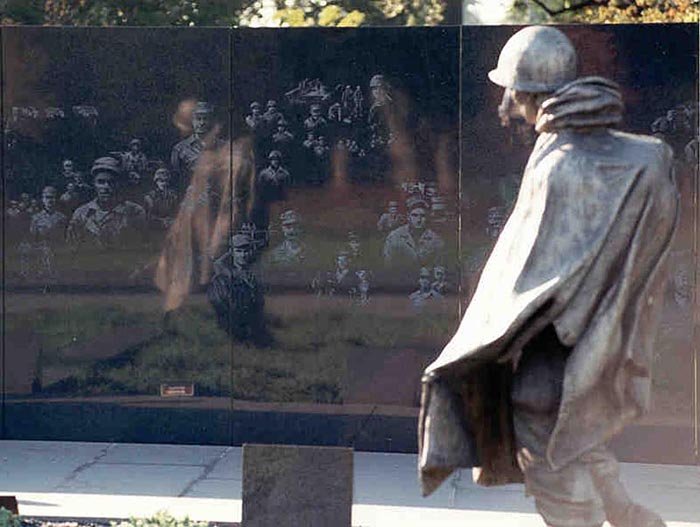
KOREAN WAR MEMORIAL – WIKIPEDIA

VIETNAM MEMORIAL WALL – WIKIPEDIA
Vietnam
In Vietnam the French were fighting their own war in a small unknown country and were soundly defeated. So, was the U.S. interested in taking over where the French left off? Of course. We started by sending 500 “advisors”, later increased our “advisors” to 16.000. Eventually we needed over 500,000 who , like the French, were defeated. We lost 58,202 good men and suffered 153,300 wounded. Was it worth losing one man? Was North Korea worth losing one man? Is Iraq worth losing one man? Again another small country had beaten us. Once again we entered a war with no plan and no desire to win. America was torn apart with violent protest over the Vietnam disgrace. Iraq is following the same path.
Iraq
Our latest war is somewhat different from Korea and Vietnam. We had no reason to get into another war and get thousands of our soldiers killed. Since we had no reason to enter into a war with Iraq, we fabricated one. Our Army is depleted to the point that we need the National Guard to come up with 140,000 men. Our equipment is outmoded and worn out. We thought we could send a few thousand troops and a few Humvees and subdue the Muslims. Well not quite. Again we had no will to win. Again, as in Vietnam, Americans are violently opposed to this senseless war. As Korea is known as “The Forgotten War”, this war is known as “The Bush War”, as apparently he is the only one that wants it. With over 3500 dead, and over 25,000 wounded with arms and legs blown off we are still making no headway. Why does the American public allow this to continue? Bush continues to push for more billions to keep the war going. Is the mission really “Accomplished.” We are running out of troops, equipment, and desire to win. So it is obvious that Congress is responsible for our runaway national debt.
Rising U.S. And China Trade Imbalance
The trade deficit and outsourcing of labor is now going out of control. The steep trade imbalance with China is costing us jobs. China’s trade dominance was first felt in the textile and clothing industries. Now the impact is spreading to high tech such as semi-conductors, aero space, and soon automobiles. At the present rate China will be producing nearly everything we use here in the U.S. This trade imbalance is costing us jobs and is reaching an unacceptable level. Hundreds of our manufacturing plants have been shut down, putting thousands of Americans out of work. Our middle class is practically non-existent.
Time To Pay
How much longer can the U.S. continue this downward trend. Is there a similarity with the 1930s depression? It all boils down to spending on credit. Eventually the bill will have to come due. Our school system is broken beyond repair with large percentages dropping out and joining gangs. Russia and China have developed a frightful array of missiles, ships, and other modern military equipment. We have shrunken from the most powerful most respected nation in the world to a third world country. With China producing everything we will not need any American workers. What few jobs remaining will be outsourced to other countries. Yes, the coming recession will surely make the last one look very puny. Our Congress is there for only one reason, TO SPEND MONEY.
Amnesty
Now after all has been said we are facing a situation that will surely bankrupt the U.S. Without voicing any opinion on the subject everyone must realize that Amnesty will cost the U.S. an estimated 2.6 Trillion. You do not have to be a mathematician to add up our debt and realize we are in trouble. This will not only affect Americans but immigrants as well. With Russia and China increasing their military might we find ourselves in a precarious position. Can this country exist when nobody has an education, when our military is gone, and everyone on drugs. If you believe we are not in trouble you should look again. What about Iran?
Website historian and Wikipedia
- The Battle of Midway: Turning the Tide in the Pacific - June 7, 2023
- The D-Day Operation of June 6, 1944 - June 6, 2023
- The B-29 that Changed History - June 4, 2023
